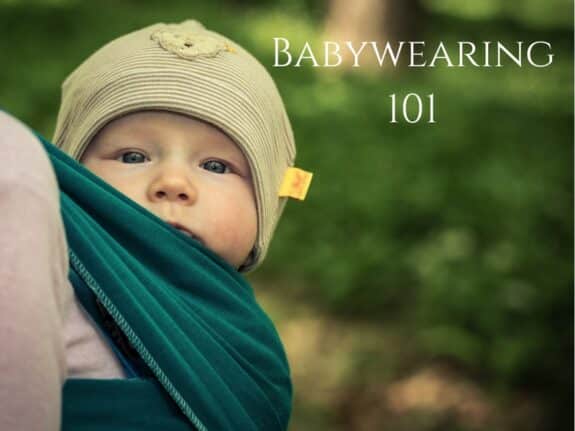Babies have been worn by their parents, perhaps since the beginning of time. It is done in poor countries, privileged countries, developed countries, and undeveloped ones. But what makes this “trend” so important? Why do so many parents do it, even without knowing all the benefits? Because, the truth of the matter is, babywearing isn’t just a trend. It is so much more.
Babywearing Makes Life a Little Easier
I was a babywearer, not out of desire, but out of necessity. Most of my babies suffered from colic issues, and those that didn’t were sensitive in other ways. They needed to be carried and held close, so that’s exactly what I did – and you know what I learned?
Babywearing makes life easier.
Who needs to lug a heavy infant carrier around when you can just carry your baby? That clunky stroller can stay in the back of your car (or take it out of the car for more room since you don’t really need it). Can’t get the cleaning done? Sure you can! Just strap the baby in and go. Have more than one kid? Babywearing also makes it possible to nurse, hold, or rock baby while tending to your other little ones. Breastfeeding while on the go is also a lot easier when you’re wearing your baby.
But babywearing isn’t just for infants. You can carry your toddler around, too! It’s great for when you’re running errands and in a hurry, or you’re in a situation where your child may get tired of walking. Just remember that your toddler does need to spend some time practicing good behavior and walking abilities, even when you’re out and about.
Babywearing Offers Benefits to Baby, Too!
Whether you have a colicky baby, a baby with special needs, or just one that seems to fuss a lot, babywearing can help. It soothes and comforts your baby by keeping them close to your body. They can smell you. They may even be able to hear your heartbeat, depending on how you have them positioned. In short, it keeps your child close to you, which is where they feel most comfortable.
Studies also suggest that babies need the closeness of babywearing because it releases oxytocin, the “love hormone.” This facilitates bonding and reduces the release of stress hormones, which may impede development. There is also some evidence to suggest that babywearing may provide other benefits, such as:
- Improved immunity against common infections and illnesses,
- Fewer ear infections,
- Decreased risk of spinal and cranial issues,
- Improved neurological development,
- Enhanced growth and weight gain,
- Regulation of baby’s temperature and breathing,
- Fewer issues with GERD, and
- Lifesaving benefits for at-risk infants.
Choosing Your Babywearing Method
Parents can choose a sling, a wrap, or carrier as their babywearing method. Each has its own benefits and possible drawbacks. For example, slings are highly versatile, with several options to choose from. You can get with an adjustment ring or one without. You can choose one that is padded or one that is unpadded. They can also be worn from infancy to toddlerhood (which is not possible with all babywearing devices). However, you must be careful when using a sling! They are, by far, the easiest for baby to slip through, especially if you haven’t got it on correctly or are using a position that your baby is not quite ready for. Make sure you use a spotter your first few tries, that way you can get used to how the carrier is supposed to sit.
Baby wraps are also versatile and easy to use. They are also less likely to result in an accident because . However, these are typically designed for younger children, so your baby may outgrow it. Still, for the fairly inexpensive cost of wraps, it may be worth the added ounce of safety. (Note that ANY babywearing device can result in an accident, so caution should still be exercised.)
Soft, structured babywearing carriers have evolved significantly over the years.
Previously thought to be one of the least comfortable for parents to wear, manufacturers have added padded shoulder straps and lumbar support to make the experience more enjoyable for new parents. Their design also makes them one of the best devices for outdoor activities and situations where you may need to do a little more bending or moving around. More ergonomic than wraps and slings tend to be, they are the best option if you’re going to be carrying your baby around for extended periods of time.
Often structured carriers are designed to be worn with the baby is many different postions; facing in, facing out, side carry and hip carry are all often intergrated into one unit which makes them very versatille for carrying a child who may get bored of a certain position. In recent years brands have started adding hoods for sleeping and protection against the elements.
Tips for Safe and Functional Babywearing
It takes time to get used to babywearing, so you should never simply head out with your baby in their carrier. Instead, take time to practice at home, over a soft surface, with someone nearby to watch and help. You should also repeat this whenever you’re ready to try a new carrying position, or when you need to trade out your old carrier for a new one.
Infants should be worn only in the front, against your chest, but you can do this either in the sling method (which means baby is essentially cradled against your chest, slightly upright, like if you were carrying them in your arms), or in the chest method (baby’s tummy is against yours). If using the chest method, be sure that the fabric is pulled all the way up to baby’s knees (their knees should be higher than their bottom), otherwise, you risk placing stress on their hip joints. Also, never let the fabric cover baby’s face; they need to be able to breathe.
Toddlers and older babies can be carried a variety of ways – against your hip, on your back, or in the front. Just make sure that baby is ready for new positions before you try them. Ideally, you want your baby to have full head and neck control and to be able to support their own spine before taking them to a position other than facing you or cradled up against you. Also, you never want to use an outward facing position that leaves your baby’s legs dangling. Such positions can cause hip dysplasia, due to a lack of support. We also suggest that you frequently check your carrier for any signs of wear and tear. Should you notice any, get a new carrier.









